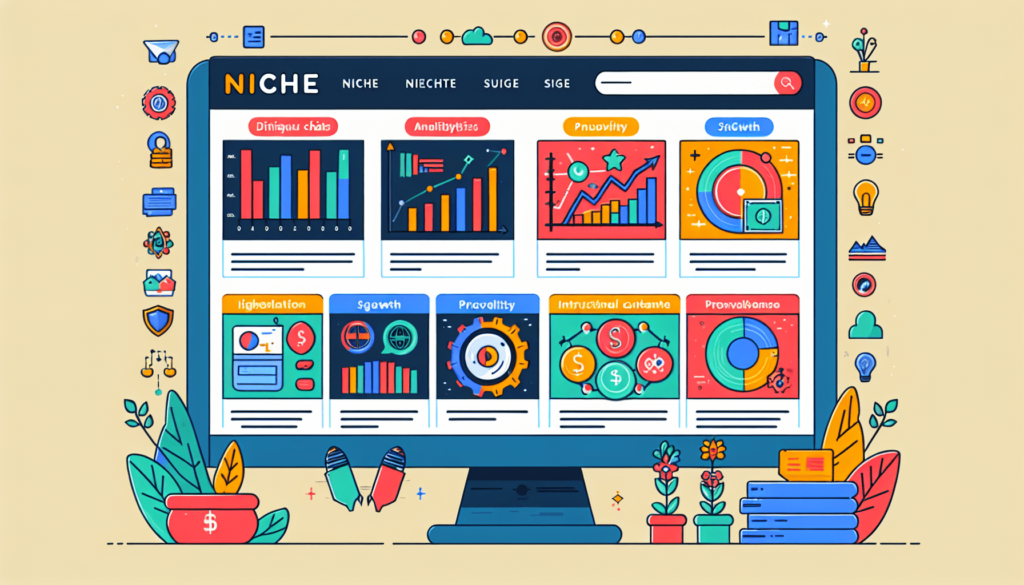Are you ready to discover the untapped wealth hidden within the realm of niche websites? If you’re seeking a way to turn your passion into profit, look no further. At BackersHub.com, we specialize in helping individuals like you unlock the full profit potential of a niche website. By combining innovation, connectivity, and the ability to capitalize on emerging trends, we provide a platform where possibilities meet profitability. Say goodbye to the days of wondering how to make money with a niche website and say hello to a world of limitless potential. It’s time to embark on a journey of financial success and fulfillment.
Unlock Earning Power: My $7 Mega Link Secret Revealed!
Finding the Right Niche
Researching profitable niches
When starting a niche website, it’s crucial to choose a niche that has the potential for profitability. We need to research different niches to identify which ones are currently in demand and have a market that is willing to spend money. By analyzing market trends, conducting keyword research, and looking at popular products or services within a specific niche, we can narrow down our options and choose a niche that aligns with our interests and has the potential for financial success.
Identifying audience needs and interests
Understanding our target audience is essential for creating a successful niche website. We need to determine what our audience needs and what interests them, so we can tailor our content and offerings to meet their expectations. This involves conducting surveys, analyzing social media conversations, and engaging in market research. By knowing our audience’s pain points, preferences, and interests, we can create a website that caters to their needs and attracts a loyal following.
Assessing competition
Before diving into a niche, it’s crucial to evaluate the competition we will face. We need to identify other websites or businesses that target a similar audience and offer similar products or services. By analyzing our competitors’ strategies, strengths, and weaknesses, we can find opportunities to differentiate ourselves and provide a unique value proposition. It’s important to make sure that the niche we choose isn’t already oversaturated with competition, as this can make it challenging to stand out and gain a significant market share.
Choosing a niche with growth potential
While it’s essential to choose a profitable niche, it’s equally important to select one that has growth potential. We want to be in a niche that is evolving and expanding, rather than one that is stagnating or declining. By researching industry trends, technological advancements, and consumer behaviors, we can identify niches that are projected to grow in the future. This allows us to position ourselves at the forefront of a developing market and capitalize on the opportunities that arise as the niche expands.
Building a High-Quality Website
Selecting a domain name
The domain name is the online address of our website, and it plays a crucial role in establishing our brand identity and attracting visitors. We should choose a domain name that is memorable, easy to spell, and relevant to our niche. Ideally, it should give users an idea of what they can expect from our website. It’s important to check the availability of the domain name and choose a reputable domain registrar to ensure that we have full control over our digital presence.
Choosing a reliable hosting provider
A reliable hosting provider is essential for ensuring our website is accessible, secure, and fast-loading. We should look for a hosting provider that offers a high uptime guarantee, robust security measures, and scalable resources. Shared hosting can be cost-effective for starting out, but as our website grows, we may need to upgrade to a dedicated server or a virtual private server (VPS). It’s crucial to read reviews, compare pricing plans, and consider the support and additional features offered by different hosting providers.
Designing an appealing website layout
The design of our website plays a vital role in attracting and engaging visitors. We should aim for a clean, modern, and visually appealing layout that reflects our brand identity. This includes choosing an appropriate color scheme, typography, and imagery that aligns with our niche. It’s important to ensure that our website is user-friendly, with clear navigation menus and intuitive layouts. A responsive design that adapts to different screen sizes is also crucial for providing a seamless browsing experience across desktop and mobile devices.
Optimizing website for search engines
Search engine optimization (SEO) is essential for driving organic traffic to our website. We should optimize our website’s structure, content, and keywords to improve our visibility in search engine results pages. This includes conducting keyword research to identify relevant search terms, optimizing meta tags and headers, improving page load speed, and creating high-quality and engaging content that appeals to both users and search engines. Regularly monitoring and analyzing our website’s SEO performance is crucial to identify areas for improvement and adjust our strategies accordingly.
Creating engaging and valuable content
High-quality content is the backbone of any successful niche website. We need to create informative, engaging, and valuable content that resonates with our target audience. This involves conducting thorough research, presenting information in a compelling way, and utilizing different types of content, such as articles, videos, infographics, and podcasts. By consistently providing valuable content that addresses our audience’s needs and interests, we can establish our website as a trusted resource and build a loyal following.

Life-Changing: How a Simple Link Brought Me Financial Freedom!
Monetization Strategies
Displaying advertisements
One popular way to monetize a niche website is by displaying advertisements. We can sign up for ad networks like Google AdSense or MediaVine that automatically display relevant ads on our website. It’s important to strategically place ads in a way that does not interfere with the user experience while maximizing revenue generation. By optimizing ad placements and targeting niches with high-paying ads, we can generate passive income from the ad impressions and clicks generated by our website visitors.
Affiliate marketing
Affiliate marketing allows us to earn a commission by promoting other companies’ products or services. We can join affiliate programs in our niche and promote relevant products through our website. By including affiliate links in our content and recommending products that we genuinely believe in, we can earn a commission for every sale that is made through our referral. It’s important to disclose affiliate partnerships transparently and focus on recommending products that align with our audience’s needs and interests.
Selling digital products or services
Creating and selling our own digital products or services is a highly profitable way to monetize a niche website. We can develop e-books, online courses, software, or other digital products that provide value to our audience. By leveraging our expertise and addressing our audience’s pain points, we can generate revenue through direct sales. Selling services related to our niche, such as consulting or coaching, can also be a lucrative option.
Offering premium content or memberships
Another monetization strategy is to offer premium content or memberships to our audience. We can create a membership site where users pay a monthly or annual fee to access exclusive content, resources, or community forums. By providing valuable and unique content that members cannot find elsewhere, we can create a recurring revenue stream. It’s important to ensure that the premium content or memberships offer significant value and justify the cost for our audience.
Sponsored posts or reviews
As our niche website gains traction and establishes authority, we can collaborate with companies and brands for sponsored posts or reviews. This involves writing an article or creating content that features or reviews a product or service in exchange for compensation. It’s essential to maintain transparency and only promote products or services that align with our audience’s interests. Building relationships with brands and negotiating fair compensation is crucial for long-term partnerships.
E-commerce integration
If our niche website is focused on selling physical products, integrating e-commerce functionality is essential. We can set up an online store and leverage platforms like Shopify or WooCommerce to streamline the selling process. It’s important to choose an e-commerce platform that is user-friendly, offers secure payment integration, and provides customization options that align with our brand. By selling products directly through our website, we can maximize revenue and provide a seamless purchasing experience for our customers.
Driving Traffic to the Website
Search Engine Optimization (SEO)
A solid SEO strategy is crucial for driving organic traffic to our niche website. By optimizing our website’s structure, content, and keywords, we can improve our visibility in search engine results pages. This involves conducting keyword research, optimizing meta tags and headers, improving page load speed, and building high-quality backlinks. Staying updated with SEO best practices and algorithms is essential for ensuring our website remains visible and competitive in search rankings.
Social media marketing
Leveraging social media platforms is an effective way to drive traffic to our niche website and engage with our target audience. We need to identify which social media platforms our audience frequent and create a presence on those channels. By regularly sharing our content, engaging with our followers, and utilizing social media advertising, we can increase brand awareness, attract new visitors, and foster a community around our niche. It’s important to create shareable content and provide value to our social media followers to encourage them to visit our website.
Email marketing
Building an email list is a valuable asset for driving repeat traffic and nurturing relationships with our audience. We can create lead magnets, such as e-books or exclusive content, to entice visitors to subscribe to our mailing list. By designing effective email campaigns that offer valuable content and promotions, we can encourage subscribers to visit our website and engage with our brand. It’s important to segment our email subscribers based on their interests and preferences to deliver targeted and relevant content.
Content marketing
Content marketing involves creating and distributing valuable and relevant content to attract and engage our target audience. By consistently producing high-quality content, optimizing it for search engines, and sharing it through various channels, we can drive traffic to our website. This includes regularly publishing blog posts, creating informative videos, hosting podcasts, and producing visually appealing infographics. By addressing our audience’s pain points and positioning ourselves as industry experts, we can establish credibility and attract a steady stream of visitors.
Guest blogging
Collaborating with influencers within our niche to guest blog on their websites is an effective way to tap into their existing audience and drive traffic to our website. By providing valuable and insightful content, we can attract their followers and encourage them to visit our website for more information. It’s important to build relationships with influencers and identify guest blogging opportunities that align with our niche and target audience. This strategy not only drives traffic but also helps in building valuable backlinks for SEO.
Paid advertising
Paid advertising can be a powerful tool for driving targeted traffic to our niche website. We can utilize platforms like Google Ads, Facebook Ads, or Instagram Ads to create highly targeted campaigns that reach our desired audience. It’s important to set a budget, define clear objectives, and continually monitor and optimize our ad campaigns to ensure we are getting the best return on investment (ROI). By leveraging paid advertising strategically, we can attract new visitors and increase brand exposure.

Daily Payday From Your Couch? Try now for the cost of a cup of coffee!
Building a Strong Brand
Crafting a unique brand identity
Establishing a unique brand identity is crucial for differentiating our niche website from competitors. We need to define our brand’s values, personality, and mission to create a strong and cohesive identity. This includes identifying our target audience’s preferences and tailoring our brand messaging and visuals to resonate with them. By consistently portraying our brand identity across all touchpoints, including our website, social media, and content, we can build brand recognition and loyalty.
Developing a memorable brand name and logo
A memorable brand name and logo are essential components of a strong brand identity. We should choose a brand name that is easy to remember, spell, and reflects our niche and values. The logo should be visually appealing, scalable, and convey our brand’s essence. It’s important to choose colors, fonts, and design elements that align with our niche and target audience. Consistently using our brand name and logo across all marketing collateral helps in building brand recognition and trust.
Creating consistent brand messaging
Consistency in brand messaging is key to building a strong brand identity. We need to develop a clear and concise brand message that communicates our unique value proposition and resonates with our target audience. This message should be used consistently across all marketing channels, ensuring that our website, social media posts, and advertising reflect our brand’s values and positioning. By reinforcing our brand message consistently, we can create a cohesive and recognizable brand identity.
Engaging with the target audience on social media
Social media platforms provide an opportunity to connect directly with our target audience and build a community around our niche. We should actively engage with our followers, respond to comments and messages promptly, and provide value through our social media content. By fostering genuine connections, showcasing our expertise, and encouraging user-generated content, we can strengthen our brand’s presence and create a loyal following. It’s important to provide timely and relevant updates, share behind-the-scenes content, and encourage conversations among our followers.
Analyzing Website Analytics
Setting up Google Analytics
Setting up Google Analytics is essential for tracking and analyzing our website’s performance. We need to create an account, add the Google Analytics tracking code to our website, and set up goals and conversions to measure the desired actions taken by users. Google Analytics provides valuable insights into website traffic, user behavior, conversion rates, and other metrics that allow us to make data-driven decisions to enhance our website’s performance.
Monitoring website traffic and user behavior
Regularly monitoring website traffic and user behavior is crucial for understanding how our audience interacts with our website. We should analyze metrics such as the number of visitors, page views, bounce rate, and average time spent on our website. By identifying trends and patterns in user behavior, we can uncover areas for improvement and make adjustments to our website’s structure and content. It’s important to track the performance of individual pages and conduct A/B testing to optimize user experience and increase conversions.
Identifying trends and patterns
Analyzing website analytics allows us to identify trends and patterns in user behavior and traffic. We can determine which pages or topics are attracting the most visitors, which marketing channels are driving the highest quality traffic, and which conversion paths are the most effective. By understanding these trends, we can tailor our content, marketing strategies, and website structure to capitalize on the areas that are performing well and improve the areas that are underperforming.
Making data-driven decisions to optimize performance
Data-driven decision-making is crucial for optimizing our website’s performance. By analyzing website analytics, we can identify areas that need improvement, set specific goals, and create actionable strategies to achieve those goals. Whether it’s improving website load speed, optimizing content for better search rankings, or refining our marketing campaigns, data allows us to make informed decisions and measure the impact of our actions. It’s important to regularly review and analyze website analytics and adjust our strategies accordingly to ensure continuous improvement.

Shocking! This one link can pay you time and time again!
Expanding Revenue Streams
Diversifying income sources
Diversifying income sources is important for mitigating risks and maximizing revenue potential. We should explore different monetization strategies beyond just advertising or affiliate marketing. By incorporating multiple revenue streams, such as selling products or services, offering premium content, or exploring sponsored posts, we can create a sustainable and diversified income stream. It’s important to evaluate the market demand, profitability, and alignment with our niche and audience when diversifying income sources.
Creating and selling digital products or courses
Creating and selling digital products or courses can be a lucrative revenue stream for a niche website. We can leverage our expertise and address our audience’s pain points by developing e-books, online courses, or other digital resources that provide value. By promoting our digital products through our website and marketing channels, we can generate revenue through direct sales. It’s important to conduct market research, create high-quality content, and strategically price and market our digital products to optimize revenue generation.
Launching a podcast or YouTube channel
Podcasting and video content have gained significant popularity, providing an opportunity to reach a wider audience and monetize our niche website. By launching a podcast or YouTube channel, we can create engaging and valuable content in audio or video format, attracting a new segment of users who prefer these mediums. We can monetize podcasts through sponsorships and advertisements, while YouTube channels can generate revenue through ads, sponsorships, and brand collaborations. Consistently producing high-quality content and building a loyal audience is key to monetizing these platforms effectively.
Offering consulting or coaching services
If we have expertise in our niche, offering consulting or coaching services can be a high-value revenue stream. We can leverage our knowledge and experience to provide one-on-one guidance, advice, and support to individuals or businesses within our niche. By establishing our credibility and demonstrating our expertise through our niche website, we can attract clients and charge a premium for our services. It’s important to market our consulting or coaching services strategically and deliver exceptional value to our clients.
Creating and selling branded merchandise
Creating and selling branded merchandise is a creative way to monetize a niche website while building brand awareness. We can design and sell merchandise, such as t-shirts, mugs, or accessories, that incorporate our brand name, logo, or niche-related designs. By offering merchandise that aligns with our audience’s interests and preferences, we can generate additional revenue while promoting our brand. It’s important to partner with a reliable supplier and create appealing designs that resonate with our target audience.
Optimizing for Mobile Devices
Implementing responsive web design
With the increasing popularity of mobile devices, it’s crucial to optimize our website for mobile users. Implementing responsive web design ensures that our website adapts seamlessly to different screen sizes, providing a consistent and user-friendly experience across desktop, smartphones, and tablets. By adjusting layouts, fonts, and touch-friendly elements, we can improve the mobile user experience and reduce bounce rates. It’s important to regularly test our website’s responsiveness and address any issues that may hinder mobile usability.
Optimizing website load time
Website load time is a critical factor in providing a positive user experience, particularly on mobile devices. We should optimize our website’s performance by compressing images, minifying CSS and JavaScript files, and leveraging caching techniques. By reducing the load time, we can minimize user frustration, improve search engine rankings, and increase conversions. Regularly monitoring and benchmarking our website’s load time is important to ensure optimal performance and identify areas for improvement.
Ensuring seamless user experience on mobile devices
In addition to responsive design and fast load times, it’s important to ensure a seamless user experience on mobile devices. This includes simplifying navigation menus, optimizing touch-friendly elements, and minimizing form input requirements. We should prioritize content that is easily consumable on smaller screens and eliminate any unnecessary distractions or pop-ups. Conducting user testing on different mobile devices and gathering feedback can help identify areas for improvement and enhance the overall mobile user experience.

Unlock Earning Power: My $7 Mega Link Secret Revealed!
Building an Email List
Creating lead magnets and opt-in forms
To build an email list, we need to entice visitors to subscribe by offering valuable lead magnets and opt-in forms. Lead magnets are free resources, such as e-books, checklists, or exclusive content, that offer value to our audience. We should create compelling lead magnets that address our audience’s pain points and provide actionable solutions. Opt-in forms should be prominently placed on our website, allowing visitors to easily subscribe to our mailing list. By leveraging lead magnets and opt-in forms strategically, we can grow our email list and nurture relationships with our audience.
Designing effective email campaigns
Once we have an email list, designing effective email campaigns is essential for engaging our subscribers and driving traffic to our website. We should create visually appealing and well-structured emails that offer valuable content, promotions, or personalized recommendations. Segmenting our email list based on subscribers’ interests and preferences allows us to deliver targeted and relevant content. It’s important to maintain a consistent sending schedule, use engaging subject lines, and optimize our emails for different devices to maximize open and click-through rates.
Segmenting email subscribers for targeted marketing
Segmenting our email subscribers based on their interests, preferences, or behaviors enables us to deliver targeted marketing campaigns that resonate with individual segments. By tailoring our content and promotions to the specific needs of each segment, we can increase engagement and conversion rates. It’s important to capture relevant data during the sign-up process and utilize email marketing automation tools to streamline the segmentation process. Continually analyzing and adjusting our segmentation strategy based on user feedback and performance metrics is crucial for maximizing the impact of our email marketing efforts.
Building and nurturing customer relationships through email
Email marketing is not just about promoting products or generating revenue; it’s also a valuable tool for building and nurturing customer relationships. We should invest in creating personalized and authentic email content that fosters a sense of community, provides value, and encourages two-way communication. By asking for feedback, responding to inquiries promptly, and providing exceptional customer support through email, we can build trust and loyalty among our subscribers. It’s important to prioritize building genuine relationships and view email as a channel for ongoing engagement rather than solely for transactional purposes.
Continuous Improvement and Growth
Staying updated with industry trends and emerging technologies
In the fast-paced world of digital marketing, it’s crucial to stay updated with industry trends and emerging technologies. We should regularly read industry blogs, attend webinars or conferences, and join relevant online communities to stay informed about the latest developments in our niche. By keeping up with changes and innovations, we can adapt our strategies accordingly and avoid being left behind by competitors. Continuous learning and professional development are essential for maintaining a competitive edge and driving long-term growth.
Testing and optimizing website elements
To optimize our website’s performance and user experience, we should regularly test and experiment with different elements. This includes testing different layouts, colors, call-to-action buttons, and content formats to identify what resonates best with our audience. A/B testing allows us to compare the performance of different variations and make data-driven decisions. By continually testing and optimizing website elements, we can improve user engagement, increase conversions, and enhance the overall effectiveness of our website.
Seeking feedback from users and implementing improvements
Feedback from our users is invaluable for identifying areas for improvement and understanding their needs and preferences. We should actively seek feedback through surveys, user testing, or comments and reviews. By listening to our audience and implementing their suggestions, we can enhance our website’s functionality, user experience, and content. Regularly engaging with our audience and showing that we value their opinions creates a sense of community and fosters loyalty.
Scaling the website’s operations and reach
As our niche website grows and becomes more successful, we may need to scale our operations to accommodate increased traffic and demand. This includes investing in additional resources, such as server upgrades, content creators, or customer support staff. It’s important to continuously evaluate and adjust our strategies to ensure they align with our long-term goals. Scaling our website’s reach may involve exploring partnerships, expanding our content distribution channels, or investing in targeted advertising campaigns. By consistently monitoring and adjusting our strategies, we can sustain growth and capitalize on new opportunities.
In conclusion, building a successful niche website requires careful research, strategic planning, and continuous improvement. By finding the right niche, building a high-quality website, implementing effective monetization strategies, and driving targeted traffic, we can unlock the profit potential of our niche website. It’s important to prioritize our audience’s needs, continuously analyze website analytics, and adapt our strategies to stay ahead in an ever-evolving digital landscape. With dedication, creativity, and a customer-centric approach, we can build a thriving niche website that generates revenue and makes a positive impact in our chosen niche.
Life-Changing: How a Simple Link Brought Me Financial Freedom!

